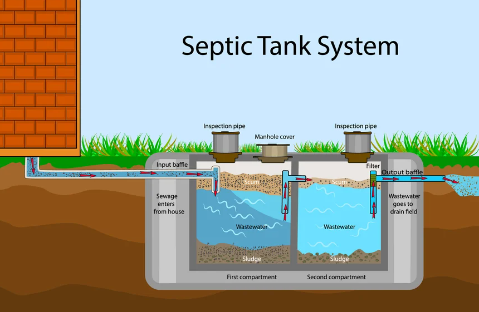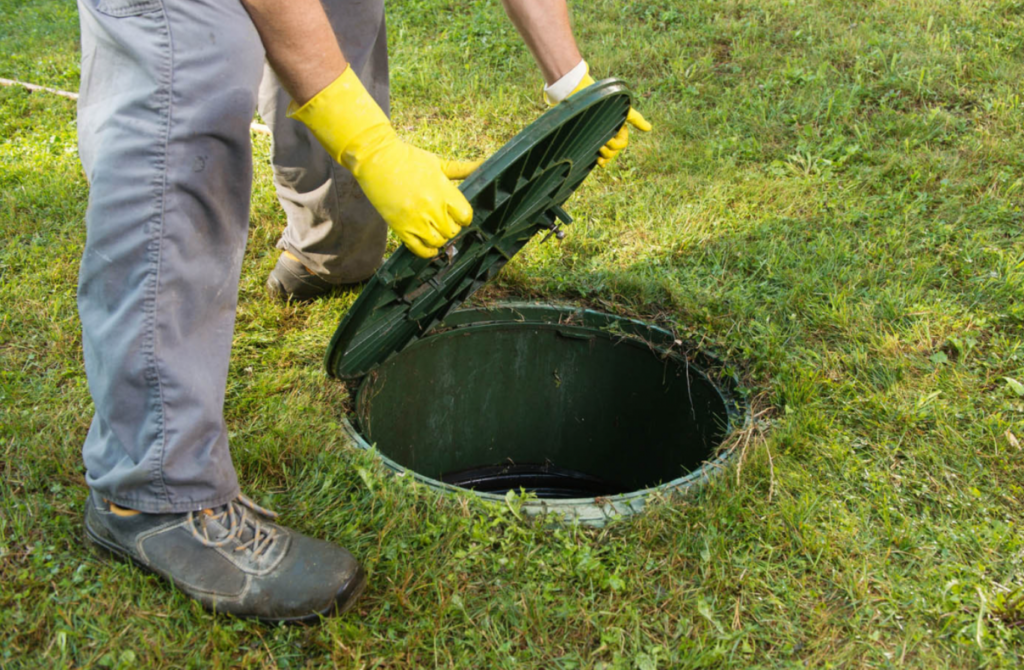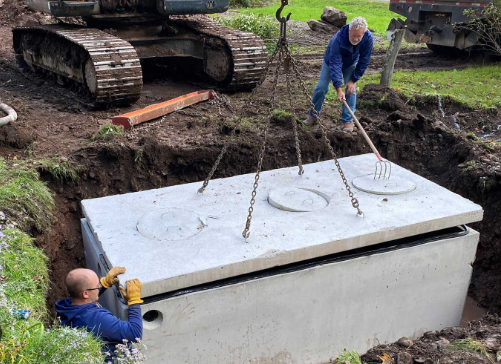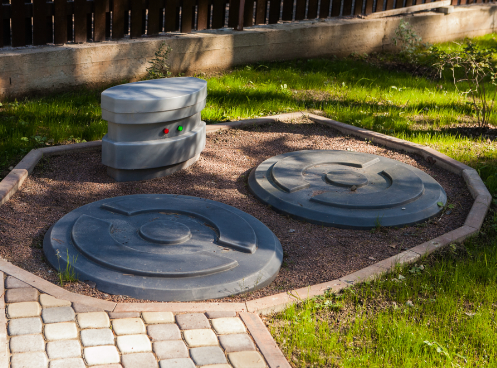Septic tanks may not be a topic that crosses your mind frequently but you sure might have asked yourself how deep are septic tanks buried really.
Nonetheless they play a pivotal role in managing household wastewater in areas without access to municipal sewer systems.
If you’re a homeowner with a septic system or are contemplating installing one, you’ve likely pondered the question: “How deep are septic tanks buried?”
The depth at which septic tanks are buried can vary based on factors like soil type, local regulations, climate, and tank size.
In general, septic tanks are typically buried a 4 inches to 4 feet below the ground’s surface to ensure effective wastewater treatment while minimizing surface disturbances.
However, specific requirements may demand deeper burial, especially in regions with cold winters where tanks are often placed below the frost line to prevent freezing.
High groundwater levels may necessitate keeping the tank above the water table to prevent buoyancy issues.
It’s crucial to consult local regulations and consider soil conditions and accessibility when determining the ideal burial depth for a septic tank installation.
How Septic Systems Work
A septic system comprises several components, with the septic tank occupying a central position in the wastewater treatment process.

When wastewater from your home, encompassing everything from toilets to sinks and laundry, enters the septic tank, a segregation process takes place. Solids settle at the tank’s bottom, while oils and greases ascend to the top.
The clarified water proceeds to the grainfield, where it undergoes natural filtration and is eventually reintroduced into the ground.
The septic tank’s core purpose is to retain, segregate, and partially treat the wastewater before it advances to the next phase of treatment.
Also read: Why Did My Toilet Seat Turn Yellow After Bleaching?
Factors Affecting Septic Tank Depth
Now that we’ve established the role of septic tanks, let’s explore the various factors that can shape the depth at which your septic tank is buried.

It’s important to realize that there’s no one-size-fits-all approach; instead, a multitude of variables come into play:
Soil Type and Composition
The type and composition of the soil in your vicinity can significantly sway the depth at which your septic tank should be buried.
Some soil varieties, such as sandy soil, may necessitate deeper burial to guarantee efficient filtration and treatment, while rocky or clay-heavy soils may call for a shallower installation.
Also read: Why Is My Toilet Water Blue?
Local Regulations and Building Codes
Local regulations and building codes are often the leading authorities in dictating minimum septic tank burial depths.
These guidelines are designed to safeguard public health and the environment.
Complying with these regulations is not only important from a legal perspective but also crucial in preventing potential health hazards.
Climate and Groundwater Levels
Your region’s climate, especially the presence of freezing temperatures in winter, can significantly influence the depth at which your septic tank should be buried.
In regions with cold winters, tanks are typically buried below the frost line to prevent freezing.
Elevated groundwater levels can also exert an influence on burial depth, necessitating that tanks be kept above the water table.
Tank Size and Capacity
The size and capacity of the septic tank you select can have a bearing on burial depth.
Larger tanks may require deeper installation, whereas smaller tanks may offer greater flexibility in their placement.
The size of your household and your water usage patterns will determine the appropriate tank size.
Also read: What’s The Maximum Distance From Toilet To Septic Tank?
Minimum Depth Requirements for Septic Tanks
So, what are the minimum depth requirements for septic tank installation?
While these requirements can vary depending on local regulations and soil conditions, here are some general guidelines:
Below the Frost Line
In regions characterized by cold winters, septic tanks are typically buried below the frost line. This depth is crucial in preventing freezing and ensuring year-round functionality.
The frost line’s depth can vary, so consulting local authorities for the specific depth in your area is advisable.

A Few Feet Deep
In many cases, septic tanks are buried 4 inches to 4 feet beneath the ground’s surface.
This depth allows for effective wastewater treatment and minimizes the risk of surface disturbances or damage.
Above the Water Table
Positioning the septic tank above the groundwater table is essential.
When the tank is situated below the water table, buoyancy issues can arise, potentially leading to damage during periods of elevated water levels.
Also read: How Far from a Septic Tank Is the Distribution Box?
Ideal Septic Tank Depth
While minimum depth requirements serve as a baseline, the ideal depth at which to bury a septic tank can fluctuate based on several considerations:
Accessibility
Accessibility is a key factor when determining the ideal depth for your septic tank. Although burying the tank very deeply may provide extended treatment time, it can complicate maintenance and repair efforts. Striking a balance between treatment efficiency and accessibility is essential.
Soil Conditions
The type of soil in your region plays a significant role in determining the ideal burial depth. Soil with favorable percolation rates may permit slightly shallower installations, while less permeable soil might require deeper burial for effective treatment.
Maintenance and Inspection
Remember that septic tanks necessitate regular maintenance and inspection. The ideal depth should facilitate easy access to the tank’s lids and components for these essential tasks. Burial that’s too deep can hinder maintenance efforts.
Local Regulations
Always consult local regulations and building codes when determining the ideal depth for your septic tank. These regulations are in place to protect public health and the environment, so adherence is crucial.
Also read: Can a Toilet and Sink Share the Same Drain?
Challenges and Solutions
While the ideal depths and minimum requirements provide a foundation, installation of septic tanks can encounter challenges. Here are some common obstacles and potential solutions:
High Water Tables
In areas characterized by high groundwater levels, you might need to elevate the tank or reposition it to ensure it remains above the water table. This precautionary measure prevents buoyancy issues and potential damage during periods of heightened water levels.
Rocky Soil
Rocky soil conditions can complicate excavation and burial. Exploring techniques such as blasting or drilling to create a suitable space for the tank or considering alternatives like above-ground tanks might be necessary.
Shallow Bedrock
The presence of shallow bedrock layers can limit burial depth. In such cases, working with an experienced contractor can help identify the optimal solution, which might entail adjustments to the tank’s placement or the use of specialized equipment.
Also read: Can A Toilet Fall Through The Floor?
Septic Tank Installation Process
The installation process for septic tanks encompasses several critical steps:
Excavation
A hole is excavated in the ground to accommodate the septic tank. The dimensions and depth of the excavation must adhere to local regulations and building codes.
Placement
The septic tank is cautiously lowered into the excavation. Ensuring proper alignment and leveling is essential to guarantee its functionality.
Inlet and Outlet Connections
Inlet and outlet pipes are securely connected to the septic tank, enabling wastewater to enter and exit the tank as part of the treatment process.
Backfilling
The area around the tank is systematically backfilled with soil, compacted in layers to deter settling. Proper backfilling is crucial to prevent any damage to the tank.
Ventilation and Access
Ventilation pipes and access points are incorporated into the tank. Ventilation is essential for the tank’s proper operation, while access points allow for regular maintenance and inspection.

Also read: DIY Toilet Tank Lid Cover: Personalizing Your Throne Room
Maintenance and Inspection
To ensure the longevity and performance of your septic tank, consistent maintenance is paramount. Here are key maintenance and inspection tasks to uphold:
Regular Pumping
Schedule routine pumping of the septic tank to eliminate accumulated solids and thwart potential clogs.
Visual Inspection
Periodically inspect the tank’s components, including the inlet and outlet pipes, baffles, and access points, to spot any signs of damage or wear.
Monitoring Water Usage
Be vigilant about your water consumption habits. Excessive water usage can overwhelm the system and lead to issues.
Professional Inspections
Consider arranging professional inspections to evaluate your septic system’s condition and identify any potential problems.
Also read: Do Amish Use Toilet Paper?
Conclusion
Gaining insight into the depth at which septic tanks are buried is crucial for homeowners who have septic systems or are contemplating their installation.
While minimum depth requirements offer a starting point, factors such as soil conditions, accessibility, and local regulations shape the ideal burial depth.
Striking a balance between effective wastewater treatment and practical maintenance is pivotal for a well-functioning septic system.
By adhering to these guidelines and considering potential challenges, you can ensure that your septic tank is appropriately positioned and maintained, thereby guaranteeing reliable wastewater treatment for years to come.
Also read: Who Makes Project Source Toilets?
Why is accessibility important in determining septic tank depth?
Striking a balance between treatment efficiency and accessibility is crucial when deciding the ideal burial depth for a septic tank. Burying the tank too deeply may extend treatment time but can complicate maintenance and repair efforts essential for long-term functionality.
What are the minimum depth requirements for septic tanks?
In regions with cold winters, septic tanks are typically buried below the frost line, and in general, tanks are often positioned 4 inches to 4 feet beneath the ground’s surface to ensure optimal wastewater treatment while minimizing surface disturbances.
Why does the depth of septic tanks vary?
The depth at which septic tanks are buried depends on factors such as soil type, local regulations, climate, and tank size, with variations influenced by considerations like effective wastewater treatment and prevention of freezing.







